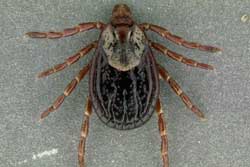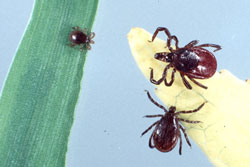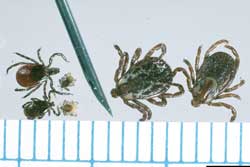Ticks
Ticks are arachnids, like spiders and mites. They are mostly found in wooded areas and the open or grassy areas at the edges of wooded areas. Approximately 850 species have been described worldwide.
Ticks are vectors of many diseases, the most important of which, for Maine, is Lyme Disease. Lyme Disease is transmitted to people by bites from deer ticks (also called black-legged ticks), not from dog ticks. When feeding, the tick makes a small incision in the skin of the host and inserts barbed piercing mouthparts to remove the blood. Most species cause little or no pain to their hosts at the time of feeding. Ticks transmit diseases by infecting hosts with microorgranisms carried on their mouthparts or in salivary fluids.

Adult American dog ticks are chestnut brown with white spots or streaks on their backs. Unfed adults are about l/8-inch long. Engorged females become slate gray and may expand to a length of l/2-inch.

Deer ticks: adults on right and nymph on left. Deer tick nymphs are very very tiny, approximately the size of a fleck of black pepper; adult females are about 1/10th of an inch when not engorged.

Relative sizes of ticks: adult and nymphal deer ticks on the left and adult American dog ticks on the right. Each line on the ruler is 1/10 centimeter.
Click on images to view full-size
Identification
- University of Maine Cooperative Extension Tick Identification Lab
- How to submit a tick for ID
- Entomological Notes: Four Common Ticks of Pennsylvania (PDF)— Penn State College of Agricultural Sciences
- Entomology Image Gallery → Ticks— Iowa State University
- TickEncounter Resource Center— University of Rhode Island
- IdentifyUS— Identification products and services
- A Guide to Tick Dragging (PDF)— Journal of Insect Science
Tick Prevention and Management
- Tickborne Diseases of the US: A Reference Manual for Healthcare Providers (PDF)— Centers for Disease Control and Prevention
- Tick ID— Video from the Maine Center for Disease Control
- Ticks: Know Your Enemy! (PDF)— Presentation with Teacher's Notes
- Tick Management Handbook (PDF)— The Connecticut Agricultural Experiment Station
- Managing Ticks on Your Property (PDF)— The Connecticut Agricultural Experiment Station
Managing Ticks on School Grounds
- Ticks: Management and Monitoring at Schools— Maine School IPM Program
- Tick Safety in Schools— U.S. Environmental Protection Agency
List of Licensed Companies Offering Tick & Mosquito Control— Maine Board of Pesticides Control
Protecting Yourself from Ticks
- Insect Repellents— US Environmental Protection Agency
- Repellent Factsheet (PDF)— Maine Center for Disease Control and Prevention
- Repellent FAQs— Maine Center for Disease Control and Prevention
- Using Insect and Tick Repellents Safely (PDF)— PennState College of Agricultural Sciences Cooperative Extension
- How to Choose Tick Control Products (PDF)— Maine Board of Pesticides Control
- The Insect Repellent DEET— U.S. Environmental Protection Agency
- Fact Sheet: Insect Repellents (PDF)— University of New Hampshire Cooperative Extension
- Personal Protection from Ticks (PDF)— The Connecticut Agricultural Experiment Station
- Protecting Yourself from Ticks (PDF)— Maine Department of Agriculture, Conservation and Forestry
Lyme and Other Tick-borne Disease Resources
- Vectors and Vectorborne Diseases— Maine Center for Disease Control & Prevention Resources
- Lyme Disease Fact Sheet (PDF)— Maine Center for Disease Control & Prevention
- Ticks and Lyme Disease— U.S. Centers for Disease Control
- Lyme & Vector-Borne Disease Laboratory— MaineHealth Institute for Research
[Photos, left to right: Gary Alpert, Harvard University, Bugwood.org; Jim Occi, BugPics, Bugwood.org; Jim Occi, BugPics, Bugwood.org]